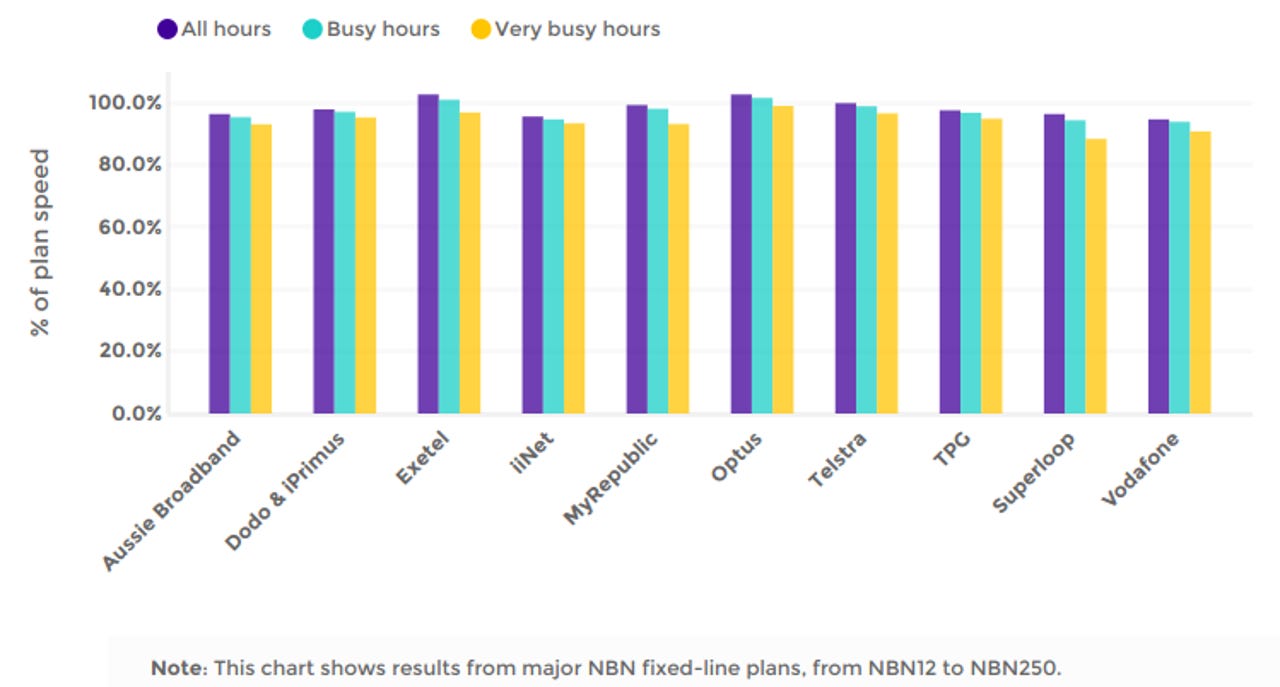Superloop and Vodafone lagging when NBN gets busiest


If you are looking for an NBN retailer that is able to provide consistent high speeds, even when the network is at its busiest, then the clear choice is Optus, according to the latest Measuring Broadband Australia report covering September 2021 issued by the Australian Competition and Consumer Commission (ACCC).
Optus was able to provide 99% of plan speed during the busiest hour -- which is defined as the "fifth-lowest hourly average download speed across each busy hour" -- followed by Exetel on 96.9%, Telstra with 96.6%, and the big improvers Dodo and iPrimus on 95.3%. At the other end of the field, iiNet provided 93.4%, Aussie Broadband gave 93.1%, Vodafone could only hit 90.8%, and Superloop dragged the chain on 88.4%.
Across all hours, Optus was able to edge out Exetel on download speeds, with Telstra in third place, although once underperforming services were excluded, Exetel took the fastest download speed crown. Even with underperforming services excluded, Vodafone, iiNet, Aussie Broadband, and Superloop could not surpass 100% of plan speed despite the ACCC's mandated overprovisioning of downsteam speeds boosting speeds by 10% to 15%.
The upload speeds section of the report was a particularly grim reading for Aussie Broadband, which had the slowest uplinks of all, only capable of hitting 82.6% of a plan's upload speed. This was followed by iiNet, which could only get 83.5%, while TPG only reached 84.2%. At the opposite end, Exetel raced ahead with 91.1%, followed by Optus on 87.7%, MyRepublic with 86.7%, and Superloop with 86.5%.
Upload speeds were consistent between all hours and busy hours, with retailers dropping up to half a percentage point in busy hours.
Distressingly for users on slower plans with only 20Mbps allocated for uploads, every telco had a lower average percentage for that plan compared to the 40Mbps plans. For instance, iiNet had the lowest percentage at 79.8% for 20Mbps plans but 88.5% for 40Mbps, Aussie Broadband recorded 79.9% for 20Mpbs plans and 88.3% for the 40Mbps plans, and Optus had 86.5% and 89.2% for its 20Mbps and 40Mbps plans, respectively.
"Given the growing importance of upload speeds to how consumers use their broadband services, the ACCC is keeping a close eye on how clear retailers are with their customers about upload speeds, and we will consider any necessary amendments to our Broadband Speeds Claims Guidance for industry," ACCC Commissioner Anna Brakey said.
Fixed wireless users continued to get a raw deal, especially when on upload speeds, where users on 25/5Mbps plans could only average 4Mbps up during busy periods.
"Consumers on the NBN Fixed Wireless Plus plan are experiencing relatively low upload speeds," Brakey said.
"A typical video conference will require 2Mbps of available upload, which means some consumers might have trouble achieving high quality while video conferencing, particularly if there are multiple conferences occurring."
In a more positive light, the report found those on 1Gbps plans saw an increase from 617Mbps to 715Mbps in the May period to between 680Mbps to 813Mbps in September. The sample for these tests was 136 services on fibre to the premises or hybrid fibre-coaxial lines, and almost 46% of the time, speeds in excess of 900Mbps were recorded. Latency on cable connections was twice that of full fibre, but the report said in real life it is unlikely to be noticeable.
The report added that some people continue to have high-speed plans, and used cables, routers, or ports that are limited to 100Mbps.
"The ACCC has engaged with RSPs to encourage them to reach out to their consumers who may be using a constrained gateway device," the report said.
Fibre to the node continues to be the slowest fixed-line technology, with users on 50Mbps having an average download speed 6Mbps lower than other connection types, and that gap extending to 16Mbps on 100Mbps connections.
Related Coverage
- When NBN promo deals end, customers and telcos revert to old speeds
- Kate McKenzie shifts to NBN chair as Switkowski departs at year end
- Labor commits to making AU$2.4b 'investment' to extend on-demand FttN upgrades
- 5G fixed wireless is not an NBN replacement for Telstra
- NBN kicks off FttN upgrade tests in Sydney Hills Shire and northern Adelaide